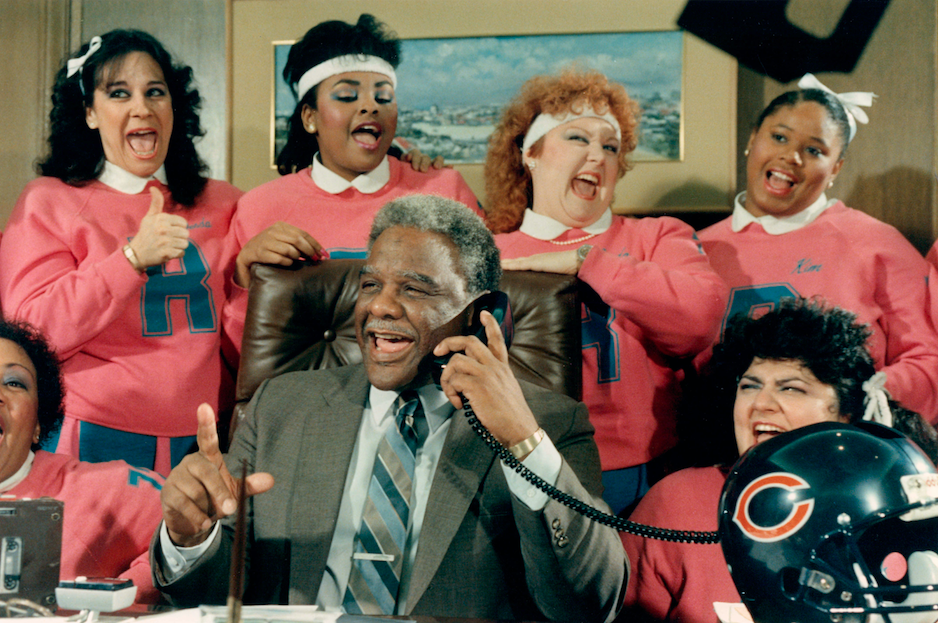Unlike most Chicagoans, Mayor Lori Lightfoot got to cheer for a winning football team last weekend.
That would be the Simeon Wolverines, who beat Lakes of Lake Villa 34 to 3 in an IHSA playoff match at Gately Stadium on Saturday. Lightfoot was in the stands, on the sidelines, and in the locker room supporting Simeon, whose playoff run was saved when she and the Chicago Teachers Union settled the 11-day teacher strike two days earlier.
“As you probably know, I love, LOVE football,” Lightfoot wrote on Instagram, beneath a photo of herself giving the team a pep talk. “And there’s nothing I love more right now than seeing the Simeon Wolverines advance in the playoffs. 34-3. Good job, gentlemen.”
It should be no surprise that Lightfoot is a huge football fan. She grew up in one of the most football-crazy towns in America: Massillon, Ohio. The mayor attended Washington High School, whose football program, formed in 1894, is one of the nation’s oldest.
“In Massillon, Ohio, high school football is everything,” wrote The Week in a photo essay on the Massillon Tigers. “Indeed, the love of this game is a birthright. Every boy born in Massillon is given a miniature football at birth. The town’s nickname is ‘Tigertown USA’; the town’s motto is ‘City of Champions.’ In a community of about 30,000 people, the high school football stadium holds 17,000 — and you can bet it’s at capacity during every home game.”
(Lightfoot was at the games, because she played trumpet in the marching band.)
As a student at the University of Chicago Law School, Lightfoot played quarterback on an intramural flag football team. For the past 20 years, she has been a Chicago Bears season ticket holder.
This is a city that’s played an important role in football history, as the birthplace of the NFL’s two oldest franchises. (The Cardinals are the other one, having moved to St. Louis then Arizona from Chicago.) It’s a city whose most popular sports team, the Bears, is in its 100th season.
Yet not every Chicaog mayor has loved football. In fact, Lightfoot’s passion for the game is a particular contrast to the predecessor to whom she’s most often compared, Harold Washington.
Washington was not a football fan. He didn’t follow sports. When Washington was mayor, the Bears threatened to leave Chicago unless they got a new stadium to replace decrepit Soldier Field, or at least a better deal on concessions from the Park District. At first, Washington was dismissive of the threats, his corporation counsel, Judson Miner, once told me. His attitude was, “Let ’em go.”
Then, in 1985, Chicago experienced the greatest season in Bears history, and maybe the greatest season in NFL history. Washington may not have been a football fan, but he was a politician. His mayoralty was the most divisive moment in the Chicago’s history, as Council Wars pitted white, black, and Latino politicians against one another for control of the city. At a time like that, Washington recognized the value of associating himself with a sports team that everyone in Chicago loved — especially white ethnic Superfans, many of whom hated the fact he was mayor.
And so, the mayor became an honorary member of the Refrigerettes, the group of unofficial cheerleaders (in place of the defunct Honey Bears) who took their name from Bears offensive lineman William “the Refrigerator” Perry. Whenever he made a bet on a game with another city’s mayor, Washington invited the Refrigerettes to City Hall. They called him “Mayor Hal.”
Washington attended Super Bowl XX in New Orleans and presented the Bears with a victory plaque in Daley Plaza at the end of the celebratory parade. The mayor donned a Bears cap and unveiled a sign naming a stretch of Lake Shore Drive after Bears founder George Halas, who had died three years earlier. The Bears success, and their fans’ delight in it, opened Washington’s eyes to football’s place in the fabric of the city he governed.
“He said, ‘There are people who live and die for these teams,’ ” Miner recalled.
Mayor Richard M. Daley, who eventually cut a deal with the Bears and the state for the $587 million renovation of Soldier Field, said Chicago should have two stadiums and two teams. That’s how it was when he was growing up in Bridgeport: The Bears played at Soldier Field, and the Cardinals played at Comiskey Park, near the Daley bungalow on South Lowe. The oldest franchise in the NFL, the Cardinals began as a neighborhood club team called the Racine Cardinals. In their pre-NFL days, the Cardinals competed against the Cornell Hamburgs, the football team of the Hamburg Athletic Club, of which Richard J. Daley was later president.
“I really believe we could get a second football team,” Daley told Comcast Sports in 2012. “I’ve always believed — the Chicago Cardinals, Bears — why is it that New York has two? Florida has three, San Francisco has two … Chicago loves sports and we could get a second team in here.
“You could build a new stadium, you could have huge international soccer teams come in, you could do the Final Four, you could do anything you wanted with a brand new stadium.”
As for Rahm Emanuel, he attended Sarah Lawrence College, which doesn’t have a football team. He regularly touts having gone two terms without giving public money to a sports stadium. But he did bring Chicago those NFL drafts.




Comments are closed.